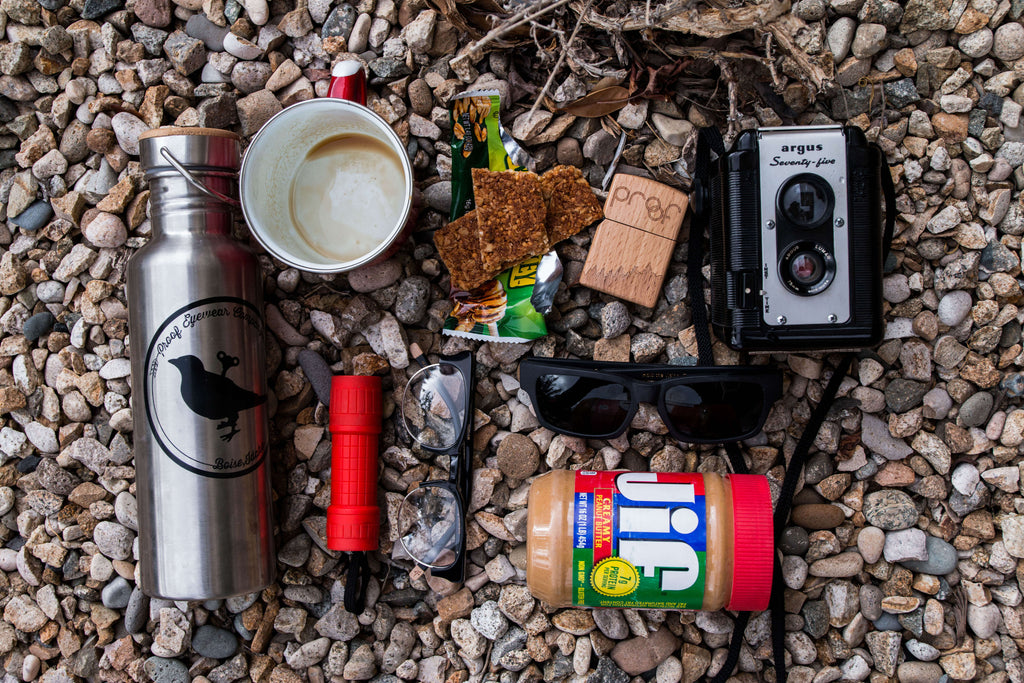4 Easy Steps to Eco Friendly Camping
Posted on by Billie Peacock
What is the key to any eco-friendly camping trip? Sustainability.
We have four easy ways to make your next camping trip sustainable.
Here at Proof we strive to use only the most eco-friendly and sustainable materials when constructing our frames. Our eco-collection is crafted from a blend of cotton based acetate and wood that has been sustainably sourced. Together these two materials create a frame that is both sturdy, stylish, and sustainable. We value sustainability because it means more time in the outdoors which allows us to connect back to our roots.
Here are our top four tips to making your next camping trip eco friendly.

Step 1. Pack the Essentials
Packing light and efficiently makes a difference when camping. Whether you are backpacking into an Alpine lake or spending the weekend in a HOA campground, what you pack makes a difference.
Our favorite camping essentials include: A lighter, Stainless Steel Water Bottle, trash bags, a sleeping bag, our Coalatree hammock, our favorite pair of Proofs, food, enamel mug, and our multi tool.
A large part of our sustainable mission means conserving water and limiting the number of plastics used in our products. We suggest the Proof stainless steel water bottle to keep your drinking water cold and refreshing while limiting plastic usage.

Don’t forget to pack for a cup of joe in the morning. Our enamel camping mug comes with a custom embossed Proof cross arrow logo. The lifetime of enamel mug can outlast the energy used to produce hundreds of plastic cups and bottles. So get to sippin’, sustainably!

Step 2. Find an Eco-Friendly Location
Location, location, location! The most important decision when choosing any adventure is to find a great location. Recently, we took a team trip to Redfish Lake in the beautiful Sawtooth National Forest. We made sure to camp close to water, fire wood, and amazing views.Talk about a great location!

An eco-friendly camping spot that is close to fresh water or a moving stream is key. This allows you to stay hydrated and bathe (or don’t bathe, your choice) without having to use disposable plastic bottles. It’s very important to note, however, that you must sterilize any water you collect before drinking it or cooking with it. Skyaboveus has a great article about how to purify your water when camping.
When picking a location, locate fallen trees to use as firewood.This will eliminate the need to pack firewood into your camping spot, and helps keep the kindling for wildfires cleaned up. Don't chop down healthy trees as they won't burn, and you'll be eliminating areas for creatures to live and thrive.

Step 3. Camp Food
Let's be honest, the best thing about camping is the food you get to make over the fire. Since packing space is limited when camping, we prefer to make food that can be combined a recycled aluminum foil. Buzzfeed has recipes to some of our favorite campfire meals. By using as few cooking utensils as possible, you reduce your trash output and your carbon footprint. Just be sure to create a separate bag that you can use to collect the used aluminum foil in. Aluminum is an infinitely recyclable material, so recycle it!

Step 4. Pack out what you pack in.
As with any adventure, this rule applies: Make sure your campsite is left cleaner than it was when you arrived. Pick up any trash you may have left, distinguish any coals from your fire, and properly dispose of any food. Leaving your campsite cleaner when you got there lets others enjoy their adventure without the worries of cleaning up after you.
Sit back, relax, and enjoy the scenery. Being eco-friendly can be as simple as you make it. From sustainable eye wear to environmentally conscious camping essentials, we’ve got you covered with gear that lasts as long as the roads you travel.

Take along some Proof camping accessories on your next adventure.
